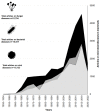Fungi's Swiss Army Knife: Pleiotropic Effect of Melanin in Fungal Pathogenesis during Cattle Mycosis
- PMID: 37755037
- PMCID: PMC10532448
- DOI: 10.3390/jof9090929
Fungi's Swiss Army Knife: Pleiotropic Effect of Melanin in Fungal Pathogenesis during Cattle Mycosis
Abstract
Fungal threats to public health, food security, and biodiversity have escalated, with a significant rise in mycosis cases globally. Around 300 million people suffer from severe fungal diseases annually, while one-third of food crops are decimated by fungi. Vertebrate, including livestock, are also affected. Our limited understanding of fungal virulence mechanisms hampers our ability to prevent and treat cattle mycoses. Here we aim to bridge knowledge gaps in fungal virulence factors and the role of melanin in evading bovine immune responses. We investigate mycosis in bovines employing a PRISMA-based methodology, bioinformatics, and data mining techniques. Our analysis identified 107 fungal species causing mycoses, primarily within the Ascomycota division. Candida, Aspergillus, Malassezia, and Trichophyton were the most prevalent genera. Of these pathogens, 25% produce melanin. Further research is required to explore the involvement of melanin and develop intervention strategies. While the literature on melanin-mediated fungal evasion mechanisms in cattle is lacking, we successfully evaluated the transferability of immunological mechanisms from other model mammals through homology. Bioinformatics enables knowledge transfer and enhances our understanding of mycosis in cattle. This synthesis fills critical information gaps and paves the way for proposing biotechnological strategies to mitigate the impact of mycoses in cattle.
Keywords: beef and dairy livestock; bovine; evasion; fungal infection; homology; knowledge transfer; melanotic fungus; orthologous genes.
Conflict of interest statement
The authors declare no conflict of interest.
Figures

Similar articles
-
The role of melanins in melanotic fungi for pathogenesis and environmental survival.Appl Microbiol Biotechnol. 2020 May;104(10):4247-4257. doi: 10.1007/s00253-020-10532-z. Epub 2020 Mar 23. Appl Microbiol Biotechnol. 2020. PMID: 32206837 Review.
-
Conservation of Mannan Synthesis in Fungi of the Zygomycota and Ascomycota Reveals a Broad Diagnostic Target.mSphere. 2018 May 2;3(3):e00094-18. doi: 10.1128/mSphere.00094-18. eCollection 2018 May-Jun. mSphere. 2018. PMID: 29720523 Free PMC article.
-
Transcriptional Control of Drug Resistance, Virulence and Immune System Evasion in Pathogenic Fungi: A Cross-Species Comparison.Front Cell Infect Microbiol. 2016 Oct 20;6:131. doi: 10.3389/fcimb.2016.00131. eCollection 2016. Front Cell Infect Microbiol. 2016. PMID: 27812511 Free PMC article. Review.
-
Analysis on the pathogenic fungi in patients with superficial mycosis in the Northeastern China during 10 years.Exp Ther Med. 2020 Dec;20(6):281. doi: 10.3892/etm.2020.9411. Epub 2020 Oct 27. Exp Ther Med. 2020. PMID: 33209125 Free PMC article.
-
Melanin and fungi.Curr Opin Infect Dis. 2003 Apr;16(2):91-6. doi: 10.1097/00001432-200304000-00005. Curr Opin Infect Dis. 2003. PMID: 12734441 Review.
References
LinkOut - more resources
Full Text Sources

